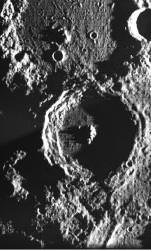 Although ESA’s SMART-1 was smashed into the Moon in 2006, it had the opportunity to gather a tremendous amount of science. Its view of this crater in particular has given ESA scientists the feeling that they might be looking at the perfect spot for a future permanent base on the Moon.
Although ESA’s SMART-1 was smashed into the Moon in 2006, it had the opportunity to gather a tremendous amount of science. Its view of this crater in particular has given ESA scientists the feeling that they might be looking at the perfect spot for a future permanent base on the Moon.
Crater Plaskett sits very close to the Moon’s north pole. This means it’s bathed in eternal sunlight. This would provide plenty of solar energy for future explorers, and creates a predictable temperature – it’s only hot, not hot and cold. Nearby craters bathed in eternal darkness might contain large stores of water ice that could be used for air, fuel and drinking water.
Crater Plaskett might provide a good first step for exploration of the Solar System. It’s close enough that astronauts would still be able to see the Earth. Help could arrive within days, if necessary, and communications would be almost instantaneous. But it’s remote enough to help mission planners understand what would be involved for future, longer duration missions on the Moon, and eventually to Mars.
SMART-1 ended its mission on September 3, 2006, when it ran out of fuel and crashed into the lunar surface. Scientists will be studying its data and images for years.
Original Source: ESA News Release
